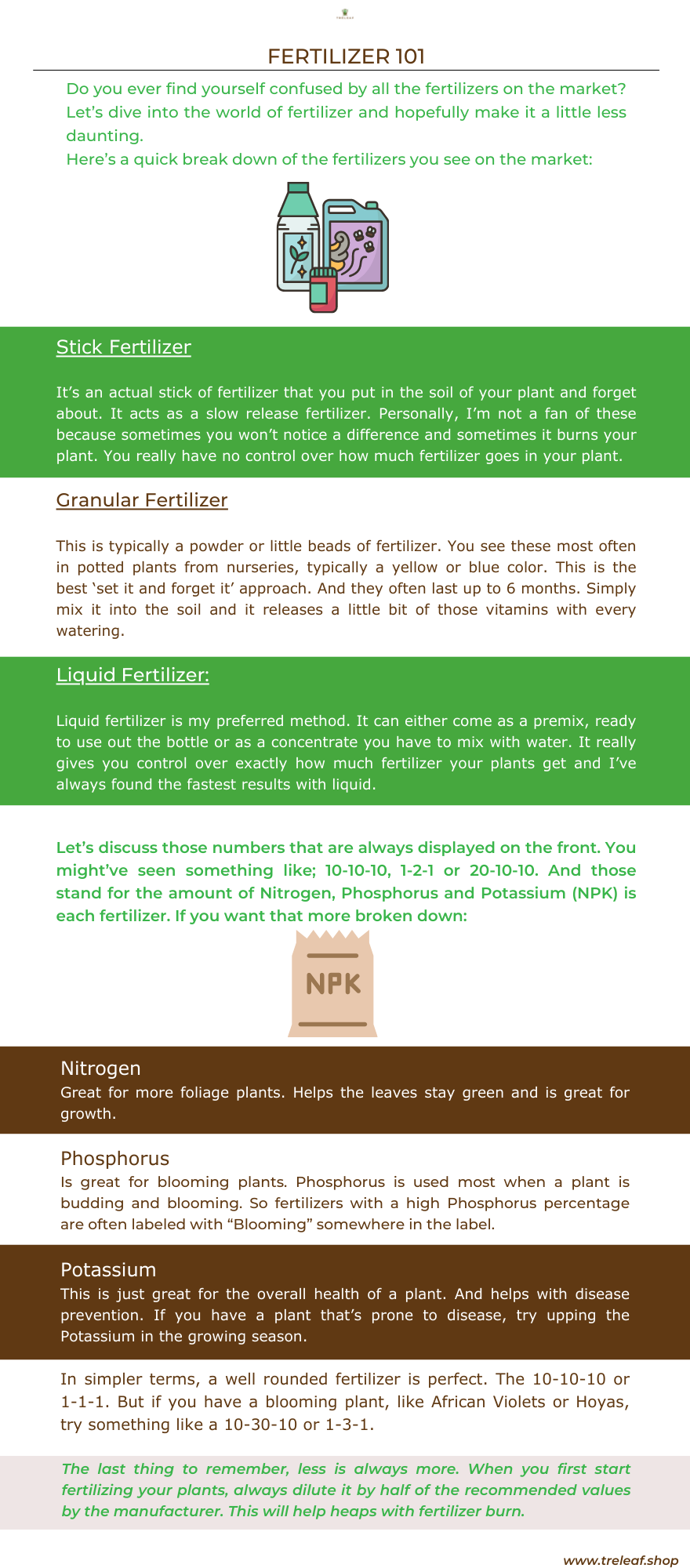Fertilizer 101
Since we’ve discussed what to do with your plants now that spring is here, let’s talk about fertilizer! Do you ever find yourself confused by all the fertilizers on the market? Between sticks, liquids and granular fertilizer, I can see how this can be overwhelming. And, what exactly do those numbers mean? Why are they on every bottle? Well, let’s dive into the world of fertilizer and hopefully make it a little less daunting.
I like to think of a fertilizer as a multivitamin for plants. They get their food from the sun—photosynthesis and the fertilizer is there to help them thrive. Out in nature, plants have all these beneficial bacteria & fungi, castings from animals, earthworms, leaf litter…all the nutrients they need to grow big and thrive. Not so much with potted plants, which is why fertilizer is so important.
Here’s a quick break down of the fertilizers you see on the market:
Stick Fertilizer:
It’s an actual stick of fertilizer that you put in the soil of your plant and forget about. It acts as a slow release fertilizer. Personally, I’m not a fan of these because sometimes you won’t notice a difference and sometimes it burns your plant. You really have no control over how much fertilizer goes in your plant.
Granular Fertilizer:
This is typically a powder or little beads of fertilizer. You see these most often in potted plants from nurseries, typically a yellow or blue color. This is the best ‘set it and forget it’ approach. And they often last up to 6 months. Simply mix it into the soil and it releases a little bit of those vitamins with every watering.
Liquid Fertilizer:
Liquid fertilizer is my preferred method. It can either come as a premix, ready to use out the bottle or as a concentrate you have to mix with water. It really gives you control over exactly how much fertilizer your plants get and I’ve always found the fastest results with liquid.
Now that we’ve covered the different types of fertilizer, let’s discuss those numbers that are always displayed on the front. You might’ve seen something like; 10-10-10, 1-2-1 or 20-10-10. And those stand for the amount of Nitrogen, Phosphorus and Potassium (NPK) is each fertilizer.
If you want that more broken down:
Nitrogen: Great for more foliage plants. Helps the leaves stay green and is great for growth.
Phosphorus: Is great for blooming plants. Phosphorus is used most when a plant is budding and blooming. So fertilizers with a high Phosphorus percentage are often labeled with “Blooming” somewhere in the label.
Potassium: This is just great for the overall health of a plant. And helps with disease prevention. If you have a plant that’s prone to disease, try upping the Potassium in the growing season.
In simpler terms, a well rounded fertilizer is perfect. The 10-10-10 or 1-1-1. But if you have a blooming plant, like African Violets or Hoyas, try something like a 10-30-10 or 1-3-1.
The last thing to remember, less is always more. When you first start fertilizing your plants, always dilute it by half of the recommended values by the manufacturer. This will help heaps with fertilizer burn.
I know this can all seem confusing, but it’s so beneficial for your plants and they will thank you and explode with new growth in the growing season.
Happy planting!
Click here to read about the best vining plants for your home.

